A Material Study of Persian-Period Silver Coins and Hacksilber from Samaria
Abstract
1. Introduction
1.1. The Production Process of Persian-Period Silver Coins from the Southern Levant
1.2. Late Persian-Period Silver Hoards from Samaria
2. Experimental Methods and Methodology
- (a)
- The silver coins and silver alloy fragments underwent visual testing (VT) to uncover macroscopic features indicative of their preservation state, assess their condition, and better understand their manufacturing methods.
- (b)
- Weight and dimensional measurements were carried out for all items. The objects’ weight was measured using a digital weighing device with a precision scale of 0.001 g, while the dimensions were recorded using a digital caliper. Items that underwent mechanical cleaning before SEM-EDS analysis had their weights documented before and after cleaning.
- (c)
- SEM observation was performed for the silver coins and hacksilber pieces, combined with EDS analysis (ESEM, Quanta 200 FEG instrument, Thermo Fisher Scientific, Waltham, MA, USA) in high vacuum mode with a secondary electron (SE) detector. SE and back-scattered electron (BSE) modes were utilized. Surface composition was determined via EDS, employing a Si(Li) liquid-cooled Oxford X-ray detector. To ascertain the silver alloy composition, only the bright metal regions observed according to BSE mode were analyzed. Areas covered with corrosion products (dark areas according to BSE mode) were not included in the average composition calculations. For each group of coins, the average composition values and standard deviations were calculated by examining six different areas or more (for most coins) on the obverse and reverse sides of each item. In total, 808 SEM-EDS measurements were performed across all the Samarian silver coins from public collections, which were categorized into 35 groups based on their typology. In addition, 88 SEM-EDS measurements were performed for the silver jewelry, 33 measurements were performed for the silver sheets, and 13 measurements were performed for the silver Sidonian and Philistian coins from the hacksilber hoard, which were categorized based on their typology (Table 2).
3. Results
3.1. Characterization of the Materials of the Samarian Coinage
3.2. Broken Pieces of Silver Ingots, Jewelry, Pieces of Scrap Silver (Hacksilber), and the Sidonian and Philistian Coins from the Hacksilber Hoard
4. Discussion
5. Conclusions
Supplementary Materials
Author Contributions
Funding
Data Availability Statement
Acknowledgments
Conflicts of Interest
References
- Oudbashi, O.; Wanhill, R. Archaeometallurgy of copper and silver alloys in the old world. AM&P Tech. Artic. 2021, 179, 24–27. [Google Scholar] [CrossRef]
- Cohen, M.; Ashkenazi, D.; Gitler, H.; Tal, O. Archaeometallurgical analysis of the provincial silver coinage of Judah: More on the chaîne opératoire of the minting process. Materials 2023, 16, 2200. [Google Scholar] [CrossRef]
- L’Héritier, M.; Baron, S.; Cassayre, L.; Téreygeol, F. Bismuth behavior during ancient processes of silver–lead production. J. Archaeol. Sci. 2015, 57, 56–68. [Google Scholar]
- Vasilescu, A.; Constantinescu, B.; Stan, D.; Radtke, M.; Reinholz, U.; Buzanich, G.; Ceccato, D. Studies on ancient silver metallurgy using SR XRF and micro-PIXE. Radiat. Phys. Chem. 2015, 117, 26–34. [Google Scholar]
- Wanhill, R.J. Embrittlement of ancient silver. J. Fail. Anal. Prev. 2005, 5, 41–54. [Google Scholar]
- Meyers, P. Production of silver in antiquity: Ore types identified based upon elemental compositions of ancient silver artifacts. In Patterns and Process: A Festschrift in Honor of Dr. Edward V. Sayre; van Zlest, L., Ed.; Smithsonian Institution: Suitland, MD, USA, 2003; pp. 271–288. [Google Scholar]
- Merkel, S.W. Evidence for the widespread use of dry silver ore in the Early Islamic period and its implications for the history of silver metallurgy. J. Archaeol. Sci. 2021, 135, 105478. [Google Scholar] [CrossRef]
- Marchand, G.; Guilminot, E.; Lemoine, S.; Rossetti, L.; Vieau, M.; Stephant, N. Degradation of archaeological horn silver artefacts in burials. Herit. Sci. 2014, 2, 5. [Google Scholar] [CrossRef]
- Untracht, O. Jewelry Concepts and Technology; Doubleday: New York, NY, USA, 2011; pp. 341–362. [Google Scholar]
- Alinezhad, Z.; Dehpahlavan, M.; Rashti, M.L.; Oliaiy, P. Elemental analysis of Seleucid’s silver coins from Hamadan Museum by PIXE Technique. Radiat. Phys. Chem. 2019, 158, 165–174. [Google Scholar] [CrossRef]
- Mortazavi, M.; Naghavi, S.; Khanjari, R.; Agha-Aligol, D. Metallurgical study on some Sasanian silver coins in Sistan Museum. Archaeol. Anthropol. Sci. 2018, 10, 1831–1840. [Google Scholar] [CrossRef]
- Civici, N.; Gjongecaj, S.; Stamati, F.; Dilo, T.; Pavlidou, E.; Polychroniadis, E.K.; Smit, Z. Compositional study of IIIrd century BC silver coins from Kreshpan hoard (Albania) using EDXRF spectrometry. Nucl. Instrum. Methods Phys. Res. Sect. B: Beam Interact. Mater. At. 2007, 258, 414–420. [Google Scholar] [CrossRef]
- Gitler, H.; Ponting, M.; Tal, O. Metallurgical analysis of southern Palestinian coins of the Persian period. Isr. Numis. Res. 2008, 3, 13–27. [Google Scholar]
- Pitarch, A.; Queralt, I.; Alvarez-Perez, A. Analysis of Catalonian silver coins from the Spanish war of independence period (1808–1814) by energy dispersive X-ray fluorescence. Nucl. Instrum. Methods Phys. Res. Sect. B 2011, 269, 308–312. [Google Scholar] [CrossRef]
- Ashkenazi, D.; Gitler, H.; Stern, A.; Tal, O. Metallurgical investigation on fourth century BCE silver jewellery of two hoards from Samaria. Sci. Rep. 2017, 7, 40659. [Google Scholar] [CrossRef]
- Ashkenazi, D.; Gitler, H.; Stern, A.; Tal, O. Archaeometallurgical characterization and manufacturing technologies of fourth century BCE silver jewelry: The Samaria and Nablus hoards as test case. Met. Microstruct. Anal. 2018, 7, 387–413. [Google Scholar] [CrossRef]
- Davis, G.; Gore, D.B.; Sheedy, K.A.; Albarède, F. Separating silver sources of Archaic Athenian coinage by comprehensive compositional analyses. J. Archaeol. Sci. 2020, 114, 105068. [Google Scholar] [CrossRef]
- Bakirov, B.A.; Kichanov, S.E.; Khramchenkova, R.K.; Belushkin, A.V.; Kozlenko, D.P.; Sitdikov, A.G. Studies of coins of medieval Volga Bulgaria by neutron diffraction and tomography. J. Surf. Investig. X-Ray Synchrotron Neutron Tech. 2020, 14, 376–381. [Google Scholar] [CrossRef]
- Hrnjić, M.; Hagen-Peter, G.A.; Birch, T.; Barfod, G.H.; Sindbæk, S.M.; Lesher, C.E. Non-destructive identification of surface enrichment and trace element fractionation in ancient silver coins. Nucl. Instrum. Methods Phys. Res. Sect. B 2020, 478, 11–20. [Google Scholar] [CrossRef]
- Pitarch, A.; Queralt, I. Energy dispersive X-ray fluorescence analysis of ancient coins: The case of Greek silver drachmae from the Emporion site in Spain. Nucl. Instrum. Methods Phys. Res. Sect. B 2010, 268, 1682–1685. [Google Scholar] [CrossRef]
- Beck, L.; Bosonnet, S.; Réveillon, S.; Eliot, D.; Pilon, F.J.N.I. Silver surface enrichment of silver–copper alloys: A limitation for the analysis of ancient silver coins by surface techniques. Nucl. Instrum. Methods Phys. Res. Sect. B 2004, 226, 153–162. [Google Scholar]
- Moreno-Suárez, A.I.; Ager, F.J.; Scrivano, S.; Ortega-Feliu, I.; Gómez-Tubío, B.; Respaldiza, M.A. First attempt to obtain the bulk composition of ancient silver–copper coins by using XRF and GRT. Nucl. Instrum. Methods Phys. Res. Sect. B 2015, 358, 93–97. [Google Scholar] [CrossRef]
- Brocchieri, J.; Vitale, R.; Sabbarese, C. Characterization of the incuse coins of the Museo Campano in Capua (Southern Italy) by X-ray fluorescence and numismatic analysis. Nucl. Instrum. Methods Phys. Res. Sect. B 2020, 479, 93–101. [Google Scholar] [CrossRef]
- Canovaro, C.; Calliari, I.; Asolati, M.; Grazzi, F.; Scherillo, A. Characterization of bronze Roman coins of the fifth century called nummi through different analytical techniques. Appl. Phys. A 2013, 113, 1019–1028. [Google Scholar] [CrossRef]
- Fabrizi, L.; Di Turo, F.; Medeghini, L.; Di Fazio, M.; Catalli, F.; De Vito, C. The application of non-destructive techniques for the study of corrosion patinas of ten Roman silver coins: The case of the Medieval Grosso Romanino. Microchem. J. 2019, 145, 419–427. [Google Scholar] [CrossRef]
- Gnesin, G.G. On the origin of metallurgical technologies in the bronze age. Powder Metallur. Met. Ceram. 2013, 52, 477–488. [Google Scholar] [CrossRef]
- Gitler, H.; Goren, Y.; Konuk, K.; Tal, O.; van Alfen, P.; Weisburd, D. XRF analysis of several groups of electrum coins. In White Gold: Studies in Early Electrum Coinage; van Alfen, P., Wartenberg, U., Eds.; The American Numismatic Society: New York, NY, USA, 2020; pp. 379–422. [Google Scholar]
- Gitler, H.; Ponting, M. Chemical analysis of medieval Islamic coin dies. Numis. Chron. 2006, 166, 321–326. [Google Scholar]
- Buttrey, T.V. The president’s address: Calculating ancient coin production: Facts and fantasies. Numis. Chron. 1993, 153, 335–351. Available online: https://www.jstor.org/stable/42666417 (accessed on 14 February 2025).
- Hajivaliei, M.; Garg, M.L.; Handa, D.K.; Govil, K.L.; Kakavand, T.; Vijayan, V.; Singh, K.P.; Govil, I.M. PIXE analysis of ancient Indian coins. Nucl. Instrum. Methods Phys. Res. Sect. B 1999, 150, 645–650. [Google Scholar] [CrossRef]
- Ingo, G.M.; Angelini, E.; De Caro, T.; Bultrini, G. Combined use of surface and micro-analytical techniques for the study of ancient coins. Appl. Phys. A Mater. Sci. Proc. 2004, 79, 171–176. [Google Scholar] [CrossRef]
- Gitler, H.; Johananoff, M.; Tal, O. A Corpus of Samarian Coinage. forthcoming.
- Gitler, H.; Tal, O. The Nablus 1968 Hoard: A Study of Monetary Circulation in the Late Fourth and Early Third Centuries BCE Southern Levant; The Numismatic Notes and Monographs; The American Numismatic Society: New York, NY, USA, 2019; Volume 171. [Google Scholar]
- Gitler, H.; Tal, O. More on the Samaria Hoard (CH 9.413 Samaria, before 1990): Coins, jewelry and the Samarian Sheqel weight standard. Rev. Belg. Numis. Sigillogr. 2020, 166, 176–197. [Google Scholar]
- Butcher, K.; Ponting, M. Rome and the East. Production of Roman provincial silver coinage for Caesarea in Cappadocia under Vespasian, AD 69–79. Oxon. J. Archaeol. 1995, 14, 63–78. [Google Scholar]
- Eshel, T.; Gilboa, A.; Yahalom-Mack, N.; Tirosh, O.; Erel, Y. Debasement of silver throughout the Late Bronze–Iron Age transition in the Southern Levant: Analytical and cultural implications. J. Archaeol. Sci. 2021, 125, 105268. [Google Scholar] [CrossRef]
- Eshel, T.; Gilboa, A.; Tirosh, O.; Erel, Y.; Yahalom-Mack, N. The earliest silver currency hoards in the southern Levant: Metal trade in the transition from the middle to the late bronze age. J. Archaeol. Sci. 2023, 149, 105705. [Google Scholar] [CrossRef]
- Eshel, T.; Yahalom-Mack, N.; Shalev, S.; Tirosh, O.; Erel, Y.; Gilboa, A. Four Iron Age silver hoards from Southern Phoenicia: From Bundles to Hacksilber. Bull. Am. Sch. Orient. Res. 2018, 379, 197–228. [Google Scholar] [CrossRef]
- Thompson, C.M. Sealed silver in iron age Cisjordan and the ‘invention’ of coinage. Oxf. J. Archaeol. 2003, 22, 67–107. [Google Scholar] [CrossRef]
- Kletter, R. Iron Age hoards of precious metals in Palestine—An ‘underground economy?’. Levant 2003, 35, 139–152. [Google Scholar] [CrossRef]
- Thompson, C.M.; Skaggs, S. King Solomon’s silver? Southern Phoenician Hacksilber hoards and the Location of Tarshish. Internet Archaeol. 2013, 35, 11141. [Google Scholar] [CrossRef]
- Ashkenazi, D.; Cohen, M.; Jeselsohn, D.; Johananoff, M.; Gitler, H.; Tal, O. A study of a late fifth century BCE jewelry, Hacksilber and coin hoard from the Samaria region. Isr. Numis. Res. 2023, 18, 7–28. [Google Scholar]
- Eshel, T.; Erel, Y.; Yahalom-Mack, N.; Gilboa, A. One thousand years of Mediterranean silver trade to the Levant: A review and synthesis of Analytical studies. J. Archaeol. Res. 2024, 32, 1–40. [Google Scholar] [CrossRef]
- Gentelli, L.; Blichert-Toft, J.; Davis, G.; Gitler, H.; Albarede, F. Metal provenance of Iron Age Hacksilber hoards in the southern Levant. J. Archaeol. Sci. 2021, 134, 105472. [Google Scholar]
- de Figueiredo Junior, J.C.D.A.; Asevedo, S.S.; de Souza e Silva, M.L.S.; Araújo, A.C.; Quites, M.R.E. The cleaning of silver objects with a basic solution of sodium glycinate: A study on artificially and naturally tarnished silver. Stud. Conserv. 2021, 66, 375–383. [Google Scholar]
- Nord, A.G.; Tronner, K. Analysis of Swedish silver coins: Silver surface enrichment, dirt, corrosion, polishing, and origins. Stud. Conserv. 2021, 66, 211–219. [Google Scholar]
- Inberg, A.; Ashkenazi, D.; Cohen, M.; Iddan, N.; Cvikel, D. Corrosion products and microstructure of copper alloy coins from the Byzantine-period Ma’agan Mikhael B shipwreck, Israel. Microchem. J. 2018, 143, 400–409. [Google Scholar]
- Palomar, T.; Oujja, M.; Llorente, I.; Barat, B.R.; Canamares, M.V.; Cano, E.; Castillejo, M. Evaluation of laser cleaning for the restoration of tarnished silver artifacts. Appl. Surf. Sci. 2016, 387, 118–127. [Google Scholar]
- Oudbashi, O.; Wanhill, R. Long-term embrittlement of ancient copper and silver alloys. Heritage 2021, 4, 2287–2319. [Google Scholar] [CrossRef]
- Kershaw, J.; Merkel, S.W.; D’Imporzano, P.; Naismith, R. Byzantine plate and Frankish mines: The provenance of silver in north-west European coinage during the long eighth century (c. 660–820). Antiquity 2024, 98, 502–517. [Google Scholar] [CrossRef]
- Pięta, E.; Lekki, J.; del Hoyo-Meléndez, J.M.; Paluszkiewicz, C.; Nowakowski, M.; Matosz, M.; Kwiatek, W.M. Surface characterization of medieval silver coins minted by the early piasts: FT-IR mapping and SEM/EDX studies. Surf. Interf. Anal. 2018, 50, 78–86. [Google Scholar] [CrossRef]
- Wanhill, R. Stress corrosion cracking in ancient silver. Stud. Conserv. 2013, 58, 41–49. [Google Scholar] [CrossRef]
- Wanhill, R.J.H. Case histories of ancient silver embrittlement. J. Fail. Anal. Preven. 2011, 11, 178–185. [Google Scholar] [CrossRef][Green Version]
- Ashkenazi, D. How can fracture mechanics and failure analysis assist in solving mysteries of ancient metal artifacts? Archaeol. Anthropol. Sci. 2020, 12, 34. [Google Scholar] [CrossRef]
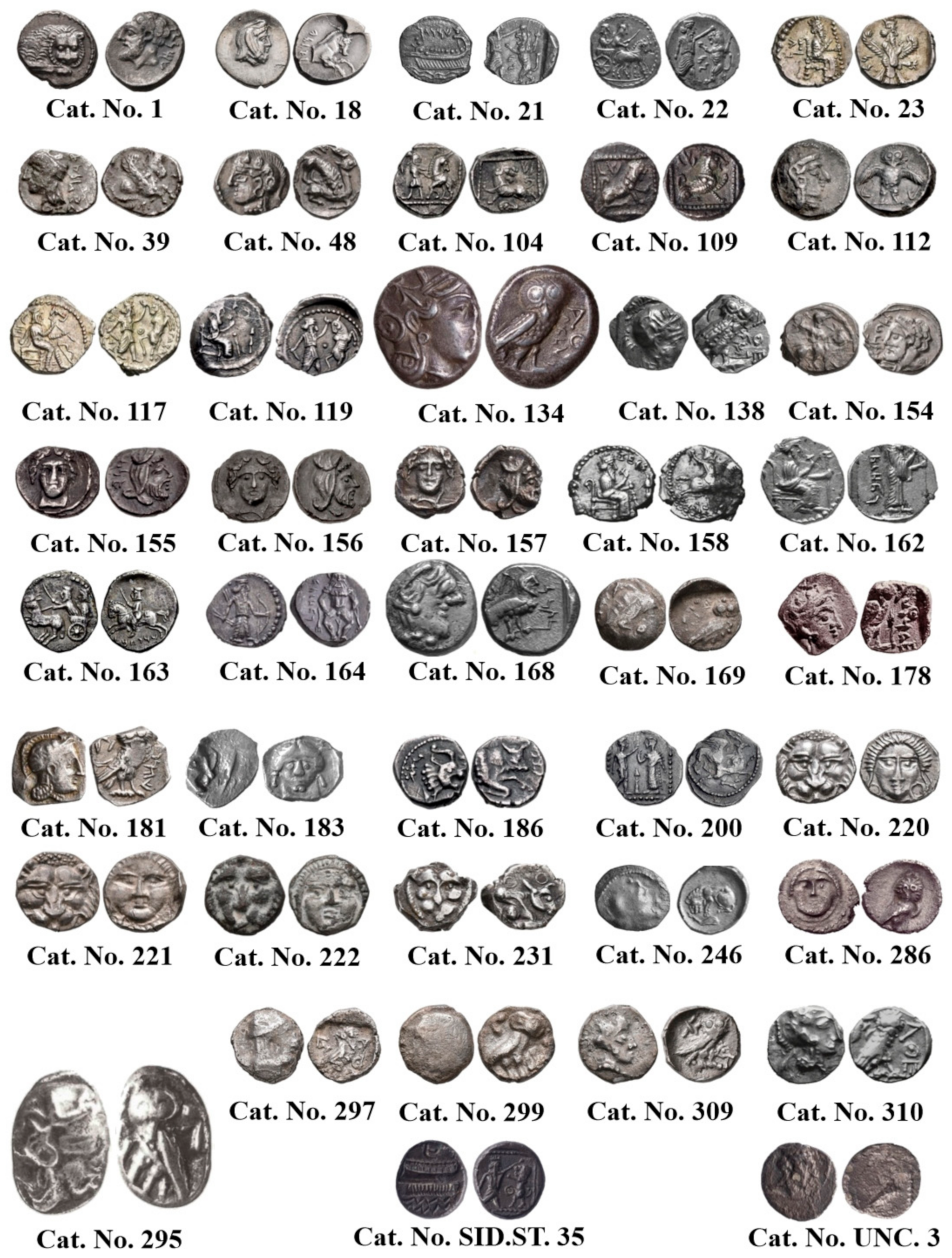



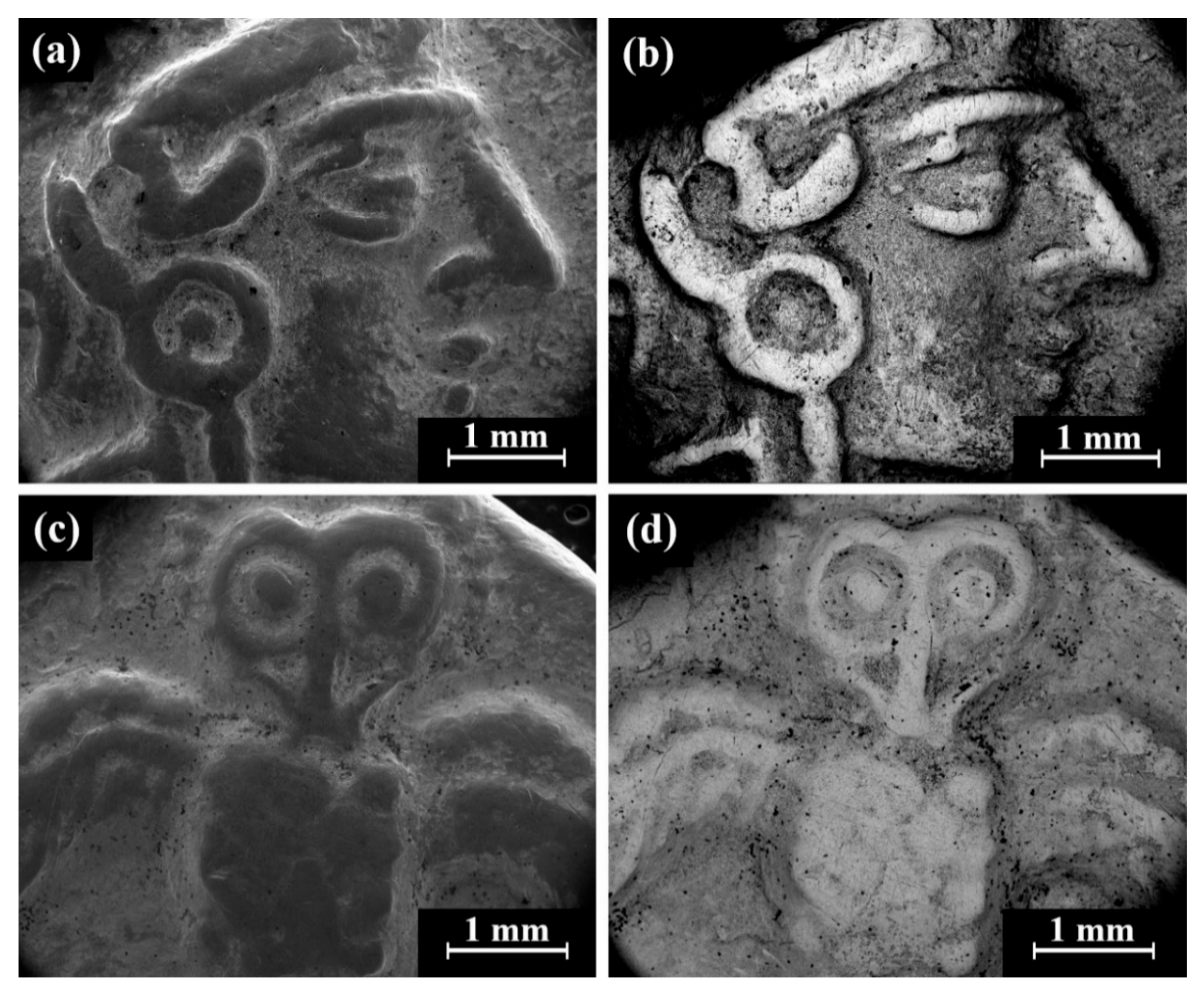
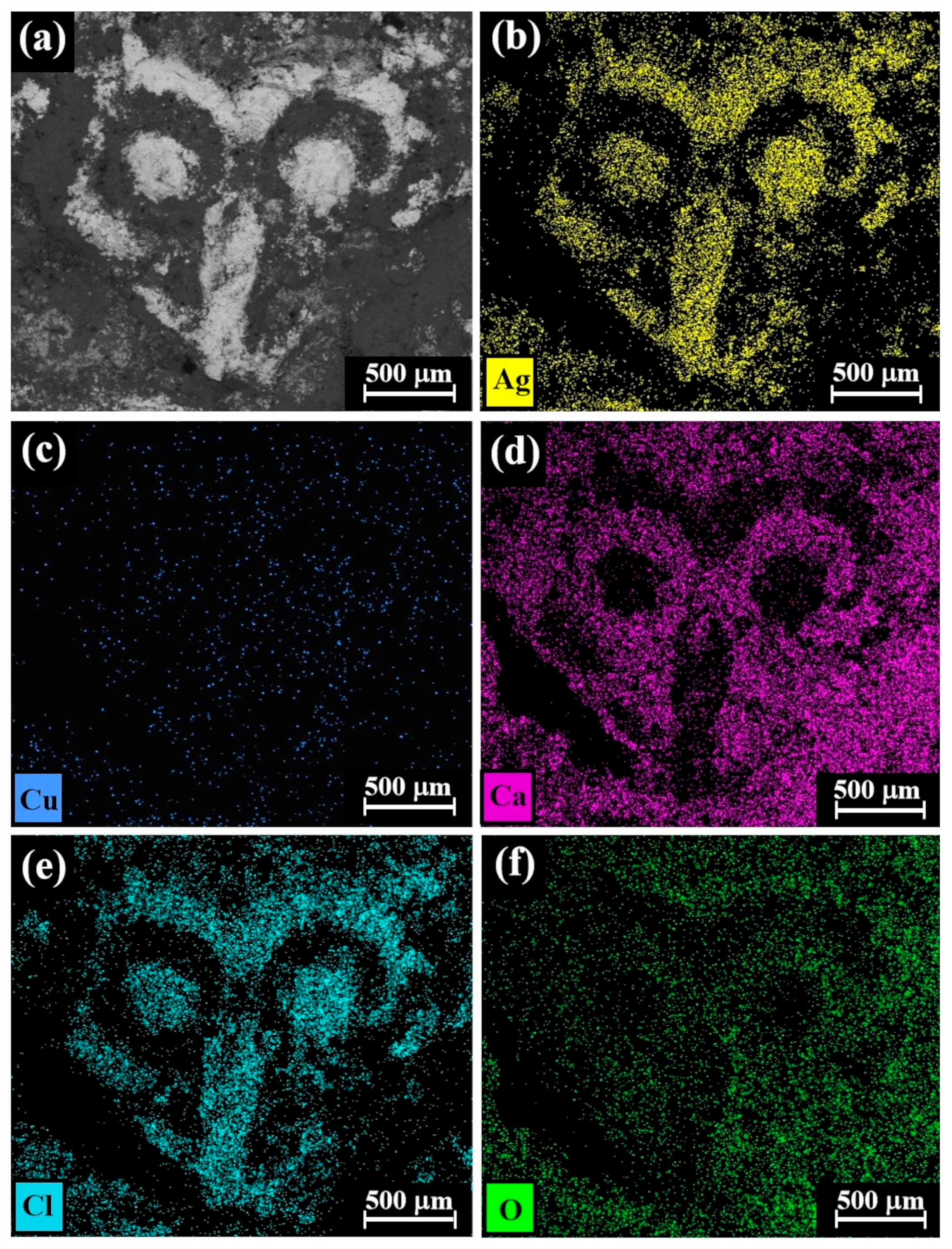
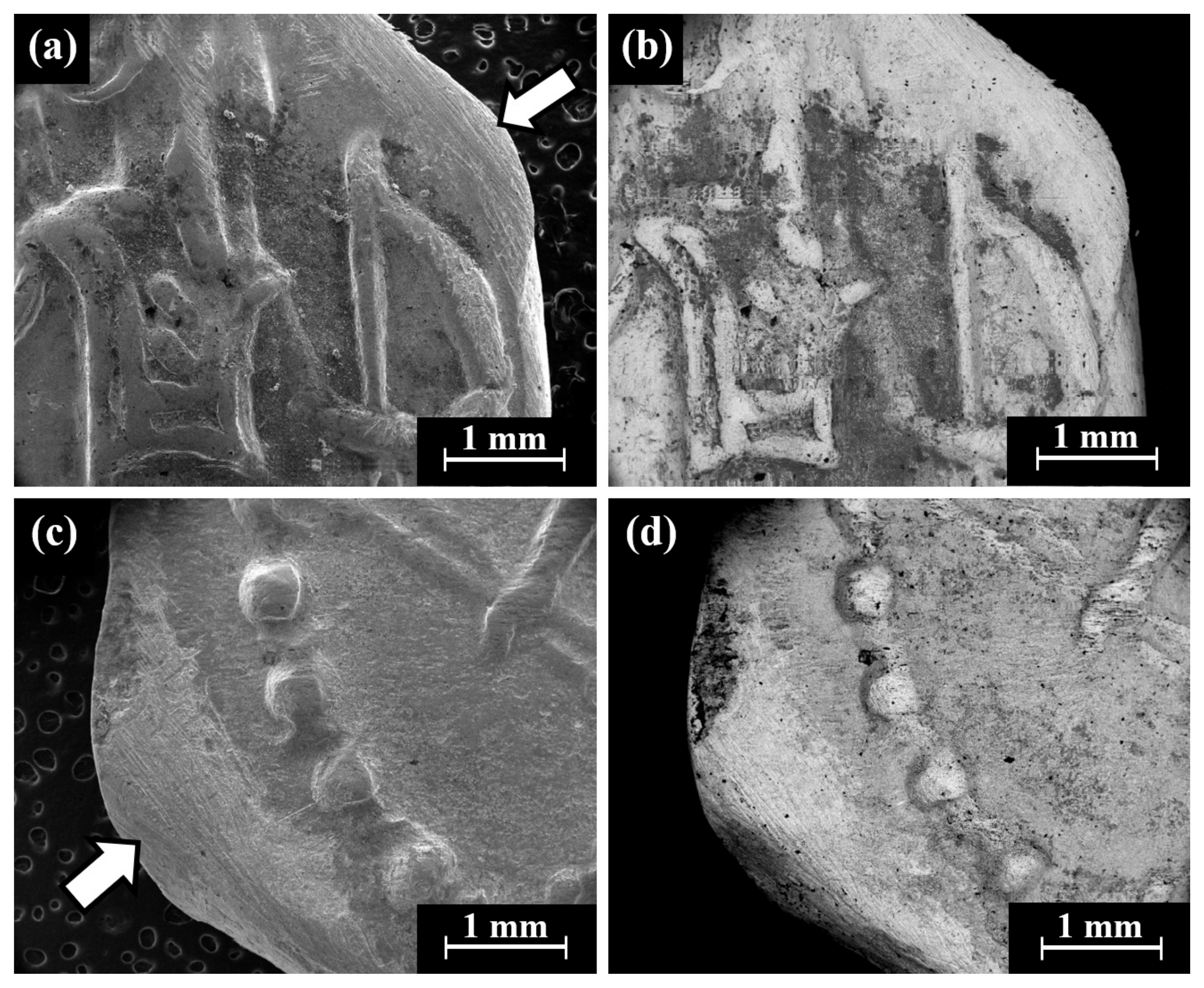
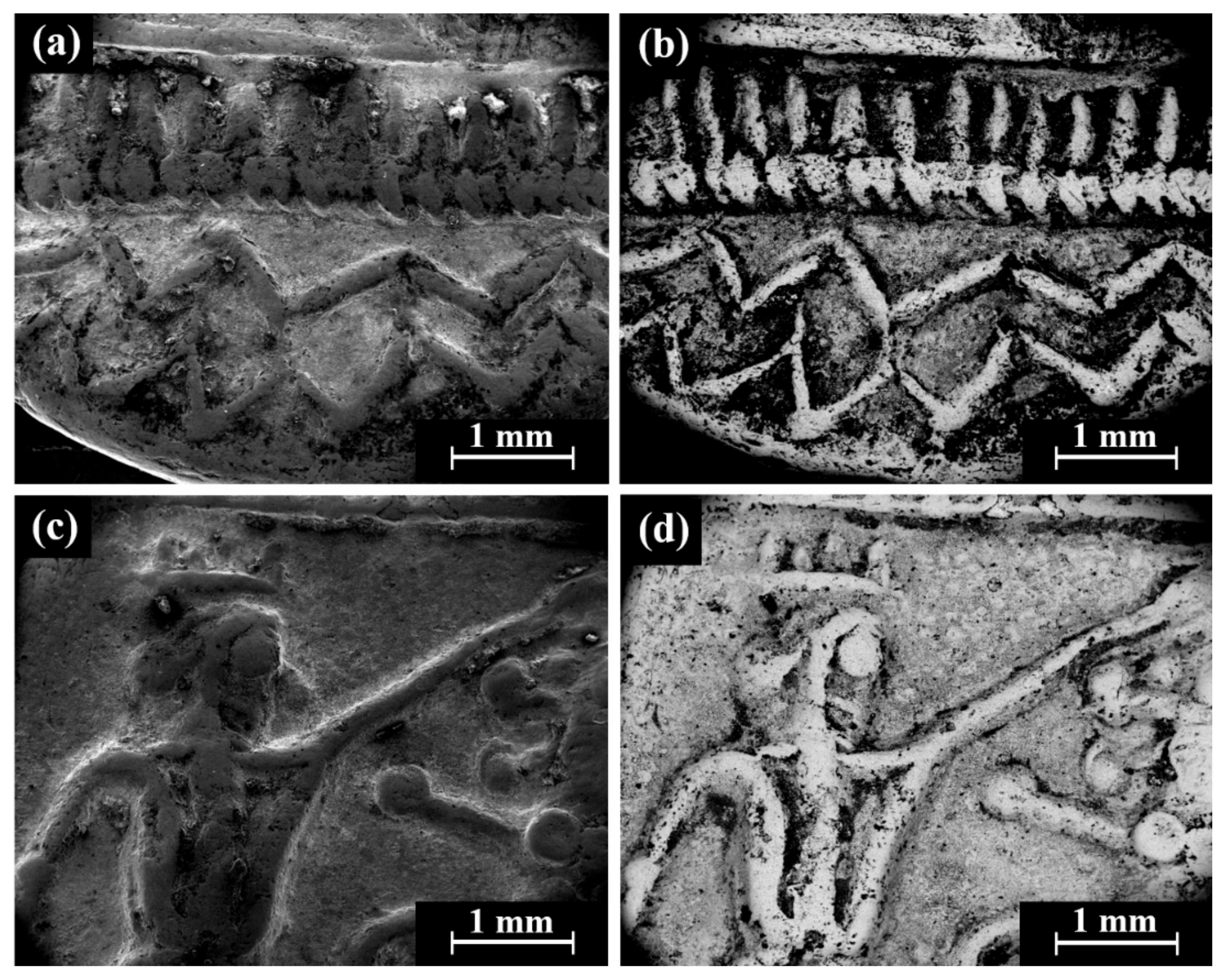
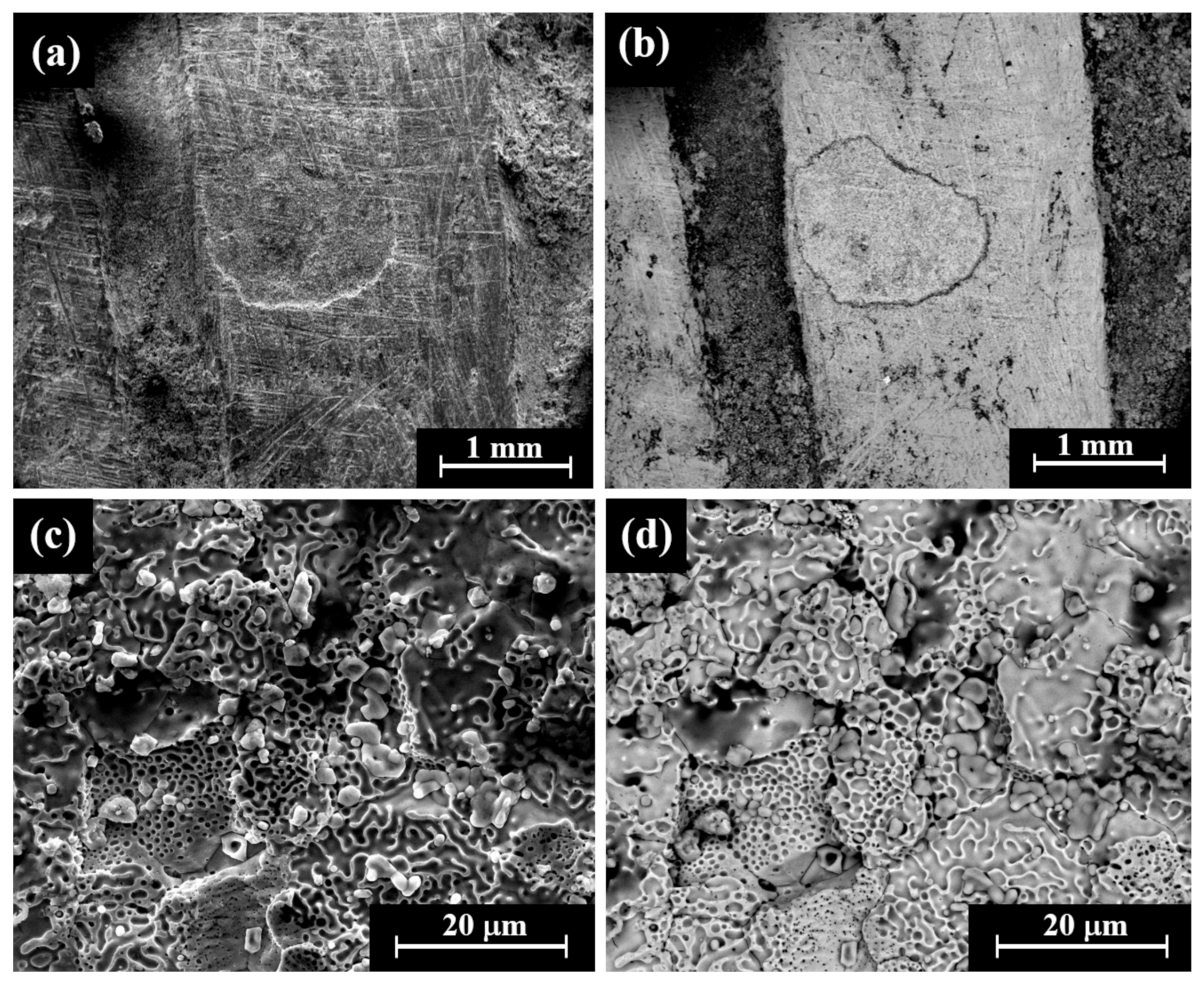
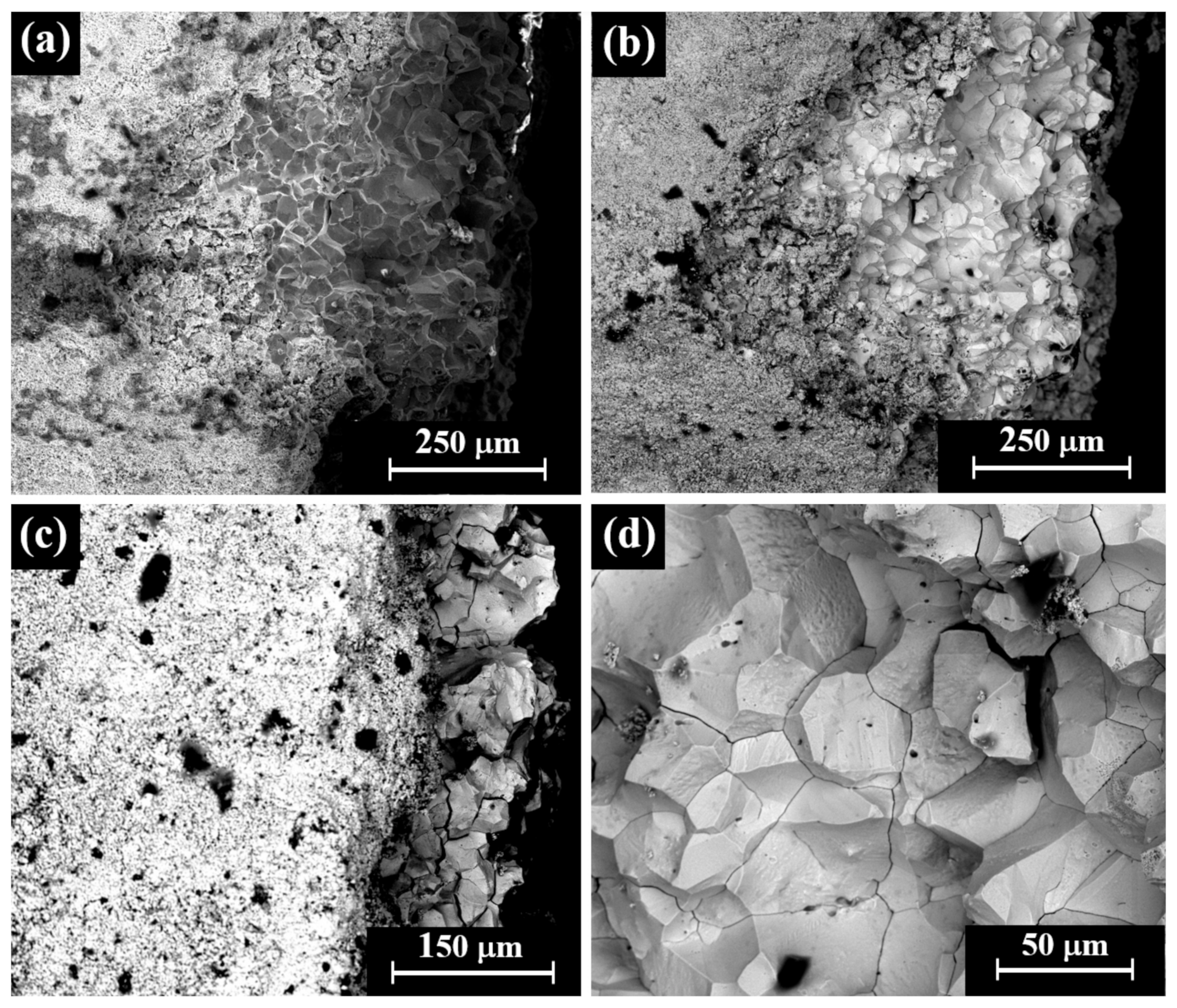
| Coin Type According to the New Typological Division of Samarian Coins | Obverse Description | Reverse Description |
|---|---|---|
| Cat. No. 1 | Forepart of crouching lion to right (r.) | Bearded male head (Heracles?) to left (l.); in r. field, ŠMRYN–שמרינ (in Aramaic) |
| Cat. No. 18 | Satrap(?) head wearing a Persian headdress to r. | Horse forepart to r.; in l. field, ŠMRYN–שמרינ (in Aramaic) |
| Cat. No. 21 | War-galley to l.; below, two lines of waves; above, ŠMRYN–שמרינ (in Aramaic) | Persian king/hero facing a lion; between them, MZ–מז (in Aramaic) |
| Cat. No. 22 | Charioteer or satrap in horse-drawn chariot to r., reins and a sword; behind, a figure wearing a crown and raising his hand | Persian king/hero facing a lion; between them, MZ–מז (in Aramaic) |
| Cat. No. 23 | Persian king(?) seated on throne to r. holding a flower and a scepter; in l. field, ŠN–שנ (in Aramaic) | Ahura Mazda to r. holding a flower and a ring(?) in the other; in l. field, MZ–מז (in Aramaic) |
| Cat. No. 39 | Male head wearing a headdress to l.; in r. field, ΦAΡΝΒAΖC (in mixed Aramaic and Greek script) | Winged horse (Pegasus or hippocamp); forepart to r.; below, NRMŠ–נרמש (in Aramaic, retrograde) |
| Cat. No. 48 | Helmeted head of Athena to l. | Lion attacking stag to r.; in l. field, ŠMRYN–שמרינ (in Aramaic) |
| Cat. No. 104 | Horse handler to l.; in l. field, ŠL–של (in Aramaic) | Lion leaping to l.; below, the lion, ram’s head to r.; in upper r. field, LŠ–לש (in Aramaic) |
| Cat. No. 109 | Lion seated to r.; in upper l. field, ŠL –של (in Aramaic) | Lion seated to r.; in upper l. field, ŠL–של (in Aramaic) |
| Cat. No. 112 | Helmeted head of Athena to r. | Owl standing facing with spread wings; Š–ש, L–ל (in Aramaic) on both sides of the wings |
| Cat. No. 117 | Satrap(?) wearing a Persian headdress; seated on diphros to r., checking an arrow; bow resting below; in upper r. field, BT–בת (in Aramaic); in l. field, numeral 14 (in Aramaic) | Persian king/hero facing a bull; pellet(?) between them; in r. field, ΒA/ΓAΒAP/ΤAC (in Greek) |
| Cat. No. 119 | Persian king(?) wearing a crown, seated on throne to r., smelling a flower and holding a scepter; incense burner in front; in upper r. field, BT–בת (in Aramaic) | Persian king/hero standing on l., facing a bull; pellet(?) between them |
| Cat. No. 134 | Helmeted head of Athena to r. | Owl standing; in upper l. field olive spray and crescent; in r. field, AΘE; ‘BD’L–עבדאל (in Aramaic) |
| Cat. No. 138 | Helmeted head of Athena to r. | Owl standing; in r. field, AΘE; in upper l. field, olive spray; ‘BD’L–עבדאל (in Aramaic) |
| Cat. No. 154 | Hero(?) holding a spear standing next to a bull or a lion | Male head (Heracles) to l.; in l. field, Y(?)RB‘M–ירבעמ (in Aramaic) |
| Cat. No. 155 | Female head (Arethusa?) facing | Bearded satrap(?) head to r.; in l. field, WNY–וני or D/RNY–ד/רני (in Aramaic) |
| Cat. No. 156 (isolated) | Female head (Arethusa?) facing | Bearded satrap(?) head to r. |
| Cat. No. 157 | Female head (Arethusa?) facing | Bearded satrap(?) head to r. |
| Cat. No. 158 | Persian king or Zeus seated on throne; in upper r. field, IEYΣ (in Greek); incense burner (thymiaterion) in front | Satrap(?) rider on horseback to r.; below, YHW‘NH–יהוענה (in Aramaic) |
| Cat. No. 162 | Persian king(?) wearing a crown, seated on throne to r., smelling a flower and holding a scepter | Persian king(?) wearing a crown standing to r., raising hand and holding a scepter; in l. field, BRWḤBL–ברוחבל (in Aramaic) |
| Cat. No. 163 | Charioteer or satrap in horse drawn chariot to l., holding reins and a sword; behind the charioteer, a figure wearing a Persian headdress and raising his hand | Satrap(?)riding horse to l., holding reins of the horse and a sword; below, BRWḤBL–ברוחבל (in Aramaic) |
| Cat. No. 164 | Persian king/hero as archer standing to r.; holding arrows and a bow; quiver on his back | Bes standing facing; in l. field, BRWḤBL–ברוחבל (in Aramaic) |
| Cat. No. 168 (isolated) | Helmeted head of Athena to r.(?) | Human (bearded male) headed bird (Ba?) to r.; in r. field NTWN–נתונ (in Aramaic) |
| Cat. No. 169 (isolated) | Helmeted head of Athena to r. | Owl standing; in r. field AΘE; in l. field, ŠLWM–שלומ (in Aramaic) |
| Cat. No. 178 (isolated) | Helmeted head of Athena to r. | Owl standing; in r. field AΘE; an ear of wheat; YDW‘–ידוע (in Aramaic) |
| Cat. No. 181 | Helmeted head of Athena to r. | Owl standing; in upper l. field, olive spray and crescent; in r. field, ŠHRW–שהרו (in Aramaic) |
| Cat. No. 183 | Helmeted head of Athena to r. | Female head facing; in upper r. field, Y–י (in Aramaic or paleo-Hebrew) |
| Cat. No. 186 | Horned lion or lynx head to r. | Bull forepart to r. |
| Cat. No. 200 | Two male figures standing facing each other (adoration scene); between them, an incense burner | Griffin attacking stag to r. |
| Cat. No. 220 (isolated) | Lion head facing | Female head (Arethusa?) facing |
| Cat. No. 221 | Lion head facing | Female head facing |
| Cat. No. 231 | Lion head facing | Bull forepart to r.; in upper field–עע (in Aramaic) or two circles |
| Cat. No. 246 | Winged mythical animal (horned lion or griffin) seated to r.; | Crouched lion to l.; eating the hindleg/thigh bone of its prey |
| Cat. No. 286 | Gorgoneion head facing | Owl standing |
| Cat. No. 295 | Helmeted head of Athena to r. | Owl standing |
| Cat. No. 297 (isolated) | Helmeted head of Athena to r. | Owl standing; in upper l. field, olive spray and crescent; in r. field, AΘE |
| Cat. No. 299 | Dome shaped | Owl standing |
| Cat. No. 309 | Helmeted head of Athena to r. | Owl standing |
| Cat. No. 310 | Helmeted head of Athena to r. | Owl standing |
| Cat. No. SID.ST. 35 (isolated) | War galley to l.; above B–ב (in Aramaic) | Persian king/hero facing a lion; between them, a circle or possibly Phoenician ‘–ע; dotted square border |
| UNC. 3 (isolated) | Female head wearing a headdress or flat crown to r. | Eagle standing to r., over thunderbolt; in r. field, club |
| Item | Description | Dimensions and Weight |
|---|---|---|
| Ornamented ring (or earring), Sample 1 | Cylindrical cast with twisted coil/wire element | External diameter: 30 mm, internal diameter 22 mm; 11.26 g |
| Ornamented earring, Sample 2 | Lunate earring | 25 mm length, 18 mm width; 5.66 g (before cleaning), 5.31 g (after cleaning) |
| Ornamented earring, Sample 3 | Broken lunate earring | 16 mm length, 15 mm width; 3.05 g (before and after cleaning) |
| Ornamented earring, Sample 4 | Broken lunate earring | 15 mm length, 20 mm width; 3.19 g (before cleaning), 3.18 g (after cleaning) |
| Ornamented earring, Sample 5 | Broken lunate earring | 27 mm length, 20 mm width; 6.25 g (before cleaning), 6.24 g (after cleaning) |
| Ornamented earring, Sample 6 | Broken lunate earring | 20 mm length, 17 mm width; 5.99 g (before cleaning), 5.97 g (after cleaning) |
| Granulated earring, Sample 7 | Broken lunate earring with attached clusters of granules | 27 mm length, 15 mm width; 4.26 g (before cleaning), 4.24 g (after cleaning) |
| Bead, Sample 8 | Two rings of seven granules each, originally adorned with seven granules on each ring | Diameter: 8 mm; 0.62 g (before cleaning), 0.60 g (after cleaning) |
| Bead, Sample 9 | Cylindrical with edges adorned with six granules each | Diameter: 4 mm, l.6 mm; 0.34 g (before cleaning), 0.33 g (after cleaning) |
| Bead, Sample 10 | Circular/spiral | Diameter of 10 mm; 1.09 g |
| Ring, Sample 11 | Broken ring with wide oval-shaped bezel with geometric design | Diameter (ring): 20 mm, bezel length 25 mm, width 19 mm; 6.57 g (before cleaning) 5.73 g (after cleaning) |
| Ring, Sample 12 | Broken ring with oval-shaped bezel with geometric design | Diameter: 11 mm, bezel 14 mm width; 11 mm length; 2.37 g (before cleaning) 2.26 g (after cleaning) |
| Ring, Sample 13 | Broken ring with oval-shaped bezel with geometric design | Bezel: 13 mm width, 14 mm length; 2.50 g (before cleaning), 2.18 g (after cleaning) |
| Ring, Sample 14a–d | Broken ring (4 fragments) | Diameter of 22 mm, 5 mm width; 2.82 g (combined) |
| Flat fragments, Sample 15 | Rectangular-shaped sheet | 21 mm length, 16 mm width, 0.2–0.4 mm thickness; 0.64 g |
| Flat fragments, Sample 16 | Rectangular-shaped sheet | 22 mm length, 19 mm width, 0.2–0.4 mm thickness; 0.83 g |
| Flat fragments, Sample 17 | Rectangular-shaped sheet | 23 mm length, 15 mm width, 0.2–0.4 mm thickness; 0.65 g |
| Flat fragments, Sample 18 | Rectangular-shaped sheet | 20 mm length, 13 mm width, 0.2–0.4 mm thickness; 0.50 g |
| Flat fragments, Sample 19 | Rectangular-shaped sheet | 20 mm length, 16 mm width, 0.2–0.4 mm thickness; 0.58 g |
| Flat fragments, Sample 20 | Rectangular-shaped sheet | 22 mm length, 20 mm width, 0.2–0.4 mm thickness; 0.78 g |
| Flat fragments, Sample 21 | Rectangular-shaped folded sheet | 9 mm length, 9 mm width, 0.2–0.4 mm thickness; 0.83 g |
| Flat fragments, Sample 22 | Rectangular-shaped sheet | 18 mm length, 16 mm width, 0.2–0.4 mm thickness; 0.59 g; (before cleaning), 0.51 g (after cleaning) |
| Block-shaped striated ingot(?), Sample 23 | Differentiate between “proper” hacksilber, which is cut from ingots, and “secondary” hacksilber made from broken precious metal “finished” items. | 20 mm length, 16 mm width, 2.5 mm thickness; 6.75 g (before cleaning), 6.45 g (after cleaning) |
| Sidonian coin, Sample 24 | Sidonian 1/16 šql, ca. 425–402 BCE | Diameter: 11 mm; 0.67 g |
| Philistian coin, Sample 25 | Philistian/Southern Levantine Athenian-styled m‘h, late fifth century BCE | Diameter: 0.9 mm; 0.60 g |
| Sample | Group | No. of EDS Measurements | Average Silver Content in the Alloy (wt% Ag) | Average Copper Content in the Alloy (wt% Cu) |
|---|---|---|---|---|
| IMJ 34127 | Cat. No. 1 | 6 | 92.0 ± 1.1 | 8.0 ± 1.1 |
| IMJ 34183 | Cat. No. 1 | 11 | 98.4 ± 2.1 | 1.6 ± 2.1 |
| IMJ 34809 | Cat. No. 1 | 7 | 94.5 ± 3.3 | 5.5 ± 3.3 |
| IMJ 34184 | Cat. No. 18 | 5 | 100 | – |
| IMJ 34343 | Cat. No. 18 | 12 | 97.7 ± 1.8 | 2.3 ± 1.8 |
| IMJ 34803 | Cat. No. 18 | 6 | 100 | – |
| IMJ 34807 | Cat. No. 112 | 6 | 99.5 ± 0.7 | 0.5 ± 0.7 |
| IMJ 34808 | Cat. No. 112 | 6 | 100 | – |
| IMJ 34353 | Cat. No. 112 | 5 | 97.2 ± 4.1 | 2.8 ± 4.1 |
| IMJ 34354 | Cat. No. 112 | 6 | 98.5 ± 0.6 | 1.5 ± 0.6 |
| NH 340 | Cat. No. 117 | 8 | 97.2 ± 1.1 | 2.8 ± 1.1 |
| NH 343 | Cat. No. 117 | 10 | 89.4 ± 6.1 | 10.6 ± 6.1 |
| NH 345 | Cat. No. 117 | 7 | 94.1 ± 0.8 | 5.9 ± 0.8 |
| NH 346 | Cat. No. 117 | 7 | 94.6 ± 1.2 | 5.4 ± 1.2 |
| NH 347 | Cat. No. 117 | 6 | 97.0 ± 2.1 | 3.0 ± 2.1 |
| NH 348 | Cat. No. 117 | 11 | 97.0 ± 1.9 | 3.0 ± 1.9 |
| NH 352 | Cat. No. 117 | 9 | 94.0 ± 2.2 | 5.0 ± 2.2 |
| NH 355 | Cat. No. 117 | 9 | 93.2 ± 1.9 | 6.8 ± 1.9 |
| NH 358 | Cat. No. 117 | 7 | 93.8 ± 1.9 | 6.2 ± 1.9 |
| NH 363 | Cat. No. 119 | 6 | 98.0 ± 0.4 | 2.0 ± 0.4 |
| NH 364 | Cat. No. 119 | 10 | 98.2 ± 0.8 | 1.8 ± 0.8 |
| NH 379 | Cat. No. 119 | 7 | 97.8 ± 0.3 | 2.0 ± 0.3 |
| NH 381 | Cat. No. 119 | 7 | 97.7 ± 0.9 | 2.3 ± 0.9 |
| NH 383 | Cat. No. 119 | 9 | 98.3 ± 0.6 | 1.7 ± 0.3 |
| NH 385 | Cat. No. 119 | 10 | 96.0 ± 1.7 | 4.0 ± 1.7 |
| NH 386 | Cat. No. 119 | 6 | 98.4 ± 0.3 | 1.6 ± 0.3 |
| NH 387 | Cat. No. 119 | 7 | 97.1 ± 0.8 | 2.9 ± 0.8 |
| NH 389 | Cat. No. 119 | 7 | 97.7 ± 0.5 | 2.3 ± 0.5 |
| NH 391 | Cat. No. 119 | 8 | 96.9 ± 1.1 | 3.1 ± 1.1 |
| IMJ 34341 | Cat. No. 156 | 12 | 100 | – |
| IMJ 34778 | Cat. No. 164 | 6 | 94.5 ± 2.7 | 5.5 ± 2.7 |
| IMJ 34836 | Cat. No. 164 | 6 | 95.3 ± 2.5 | 4.7 ± 2.5 |
| IMJ 34877 | Cat. No. 164 | 6 | 92.4 ± 2.2 | 7.6 ± 2.2 |
| NH 429 | Cat. No. 168 | 9 | 99.6 ± 0.7 | 0.4 ± 0.7 |
| NH 453 | Cat. No. 169 | 7 | 97.2 ± 1.5 | 2.8 ± 1.5 |
| IMJ 34197 | Cat. No. 178 | 4 | 89.3 ± 6.4 | 10.7 ± 6.4 |
| IMJ 34831 | Cat. No. 186 | 6 | 96.9 ± 0.7 | 3.1 ± 0.7 |
| IMJ 34833 | Cat. No. 186 | 6 | 95.3 ± 0.9 | 4.7 ± 0.9 |
| IMJ 34410 | Cat. No. 186 | 6 | 96.4 ± 1.4 | 3.6 ± 1.4 |
| IMJ 34411 | Cat. No. 186 | 6 | 98.0 ± 1.1 | 2.0 ± 1.1 |
| IMJ 34413 | Cat. No. 186 | 6 | 97.8 ± 0.7 | 2.2 ± 0.7 |
| NH 468 | Cat. No. 200 | 9 | 97.5 ± 0.5 | 2.5 ± 0.5 |
| NH 469 | Cat. No. 200 | 9 | 96.9 ± 0.9 | 3.1 ± 0.9 |
| NH 471 | Cat. No. 200 | 6 | 94.8 ± 1.4 | 5.2 ± 1.4 |
| NH 472 | Cat. No. 200 | 9 | 98.3 ± 0.6 | 1.7 ± 0.6 |
| IMJ 34421 | Cat. No. 220 | 6 | 100 | – |
| IMJ 34425 | Cat. No. 231 | 6 | 97.3 ± 1.1 | 2.7 ± 1.1 |
| IMJ 34426 | Cat. No. 231 | 3 | 96.4 | 3.6 |
| IMJ 34496 | Cat. No. 286 | 6 | 98.5 ± 0.5 | 1.5 ± 0.5 |
| IMJ 34497 | Cat. No. 286 | 6 | 98.1 ± 1.0 | 1.9 ± 1.0 |
| NH 499 | Cat. No. 295 | 9 | 97.8 ± 0.9 | 2.2 ± 0.9 |
| NH 501 | Cat. No. 295 | 11 | 96.4 ± 1.8 | 3.6 ± 1.8 |
| NH 522 | Cat. No. 297 | 6 | 96.9 ± 2.2 | 3.1 ± 2.2 |
| NH 560 | Cat. No. 310 | 6 | 98.1 ± 0.3 | 1.9 ± 0.3 |
| NH 565 | Cat. No. 310 | 6 | 96.4 ± 1.3 | 3.6 ± 1.3 |
| IMJ 34487 | SID.ST. 35 | 6 | 96.3 ± 2.4 | 3.7 ± 2.4 |
| IMJ 34503 | UNC. 3 | 6 | 99.9 ± 0.3 | 0.1 ± 0.3 |
| Coin Type | No. of Coins | No. of EDS Measurements | Average Silver Content in the Alloy (wt% Ag) | Average Copper Content in the Alloy (wt% Cu) |
|---|---|---|---|---|
| Cat. No. 1 | 3 | 24 | 95.7 ± 3.6 | 4.3 ± 3.6 |
| Cat. No. 18 | 3 | 23 | 98.8 ± 1.7 | 1.2 ± 1.7 |
| Cat. No. 21 | 2 | 14 | 95.2 ± 3.5 | 4.8 ± 3.5 |
| Cat. No. 22 | 2 | 7 | 97.8 ± 1.6 | 2.2 ± 1.6 |
| Cat. No. 23 | 4 | 30 | 96.7 ± 1.2 | 3.3 ± 1.2 |
| Cat. No. 39 | 2 | 12 | 93.8 ± 5.0 | 6.2 ± 5.0 |
| Cat. No. 48 | 2 | 12 | 98.0 ± 5.3 | 2.0 ± 5.3 |
| Cat. No. 104 | 3 | 18 | 99.8 ± 0.5 | 0.2 ± 0.5 |
| Cat. No. 109 | 4 | 24 | 97.2 ± 2.1 | 2.8 ± 2.1 |
| Cat. No. 112 | 4 | 23 | 98.9 ± 2.2 | 1.1 ± 2.2 |
| Cat. No. 117 | 9 | 74 | 94.4 ± 3.7 | 5.6 ± 3.7 |
| Cat. No. 119 | 10 | 77 | 97.6 ± 1.2 | 2.4 ± 1.2 |
| Cat. No. 134 | 3 | 23 | 96.2 ± 2.8 | 3.8 ± 2.8 |
| Cat. No. 138 | 2 | 12 | 97.5 ± 1.1 | 2.5 ± 1.1 |
| Cat. No. 154 | 2 | 12 | 98.1 ± 0.7 | 1.9 ± 0.7 |
| Cat. No. 155 | 3 | 18 | 99.0 ± 1.4 | 1.0 ± 1.4 |
| Cat. No. 156 (isolated) | 1 | 12 | 100 | – |
| Cat. No. 157 | 2 | 12 | 98.0 ± 1.5 | 2.0 ± 1.5 |
| Cat. No. 158 | 2 | 18 | 98.5 ± 0.5 | 1.5 ± 0.5 |
| Cat. No. 162 | 2 | 16 | 95.0 ± 2.3 | 5.0 ± 2.3 |
| Cat. No. 163 | 2 | 14 | 97.1 ± 1.3 | 2.9 ± 1.3 |
| Cat. No. 164 | 3 | 18 | 94.0 ± 2.7 | 6.0 ± 2.7 |
| Cat. No. 168 (isolated) | 1 | 9 | 99.6 ± 0.7 | 0.4 ± 0.7 |
| Cat. No. 169 (isolated) | 1 | 7 | 97.2 ± 1.5 | 2.8 ± 1.5 |
| Cat. No. 178 (isolated) | 1 | 4 | 89.3 | 10.7 |
| Cat. No. 181 | 2 | 12 | 92.1 ± 4.2 | 7.9 ± 4.2 |
| Cat. No. 183 | 2 | 14 | 98.2 ± 0.7 | 1.8 ± 0.7 |
| Cat. No. 186 | 6 | 30 | 96.9 ± 1.4 | 3.1 ± 1.4 |
| Cat. No. 200 | 4 | 33 | 97.1 ± 1.5 | 2.9 ± 1.5 |
| Cat. No. 221 | 2 | 12 | 98.0 ± 1.5 | 2.0 ± 1.5 |
| Cat. No. 220 (isolated) | 1 | 6 | 100 | – |
| Cat. No. 231 | 2 | 9 | 97.2 ± 0.8 | 2.8 ± 0.8 |
| Cat. No. 246 | 2 | 12 | 98.8 ± 1.6 | 1.2 ± 1.6 |
| Cat. No. 286 | 2 | 12 | 98.3 ± 0.8 | 1.7 ± 0.8 |
| Cat. No. 295 | 3 | 20 | 97.0 ± 1.6 | 3.0 ± 1.6 |
| Cat. No. 297 (isolated) | 1 | 6 | 96.9 ± 2.2 | 3.1 ± 2.2 |
| Cat. No. 299 | 2 | 12 | 95.4 ± 3.4 | 4.6 ± 3.4 |
| Cat. No. 309 | 4 | 32 | 97.2 ± 1.2 | 2.8 ± 1.2 |
| Cat. No. 310 | 2 | 12 | 97.3 ± 1.3 | 2.7 ± 1.3 |
| Cat. No. SID.ST. 35 (isolated) | 1 | 6 | 96.3 ± 2.4 | 3.7 ± 2.4 |
| UNC. 3 (isolated) | 1 | 6 | 99.9 ± 0.3 | 0.1 ± 0.3 |
| Object | No. of EDS Measurements | Average Ag (wt%) Content in the Alloy | Average Cu (wt%) Content in the Alloy | Average Au (wt%) Content in the Alloy |
|---|---|---|---|---|
| Ornamented ring (or earring), Sample 1 | 4 | 95.1 ± 0.8 | 1.8 ± 0.6 | 3.1 ± 0.2 |
| Ornamented earrings, Samples 2–6 | 14 | 92.2 ± 6.9 | 4.2 ± 6.2 | 3.6 ± 4.9 |
| Decorated lunate earring, Sample 7 | 3 | 76.0 | 1.4 | 22.6 |
| Bead made of granules, Sample 8 | 4 | 100 | – | – |
| Bead, joints between granules, Sample 8 | 5 | 100 | – | – |
| Cylindrical bead, granules, Sample 9 | 5 | 99.7 ± 0.6 | 0.3 ± 0.6 | – |
| Cylindrical bead, joints between granules, Sample 9 | 8 | 99.6 ± 0.7 | 0.4 ± 0.7 | – |
| Circular/spiral bead, Sample 10 | 4 | 90.8 ± 5.8 | 8.0 ± 5.8 | 1.2 ± 1.3 |
| Oval-shaped decorated bezel rings, Samples 11–13 | 20 | 92.0 ± 2.3 | 3.5 ± 1.2 | 4.5 ± 2.6 |
| Broken ring fragments, Sample 14 | 21 | 95.9 ± 2.6 | 1.2 ± 1.7 | 2.9 ± 2.1 |
| Sheet, Sample 15 | 3 | 95.2 | 2.1 | 2.7 |
| Sheet, Sample 16 | 4 | 94.3 ± 1.8 | 4.1 ± 2.6 | 1.6 ± 1.0 |
| Sheet, Sample 17 | 3 | 97.0 | 0.9 | 2.1 |
| Sheet, Sample 18 | 3 | 96.5 | 0.8 | 2.7 |
| Sheet, Sample 19 | 3 | 100 | – | – |
| Sheet, Sample 20 | 4 | 85.8 ± 8.7 | 14.2 ± 8.7 | – |
| Sheet, Sample 21 | 3 | 95.3 | 6.2 | 0.5 |
| Sheet, Sample 22 | 7 | 97.4 ± 0.5 | 2.3 ± 0.7 | 0.3 ± 0.7 |
| Sheets, Samples 15–22 | 30 | 95.2 ± 5.5 | 3.2 ± 5.8 | 1.6 ± 1.7 |
| Striated ingot, Sample 23 | 3 | 97.5 | 0.4 | 2.1 |
| Sidonian coin, Sample 24 | 8 | 99.8 ± 0.5 | 0.2 ± 0.5 | – |
| Philistian coin, Sample 25 | 5 | 99.7 ± 0.4 | 0.3 ± 0.4 | – |
Disclaimer/Publisher’s Note: The statements, opinions and data contained in all publications are solely those of the individual author(s) and contributor(s) and not of MDPI and/or the editor(s). MDPI and/or the editor(s) disclaim responsibility for any injury to people or property resulting from any ideas, methods, instructions or products referred to in the content. |
© 2025 by the authors. Licensee MDPI, Basel, Switzerland. This article is an open access article distributed under the terms and conditions of the Creative Commons Attribution (CC BY) license (https://creativecommons.org/licenses/by/4.0/).
Share and Cite
Ashkenazi, D.; Cohen, M.; Gitler, H.; Johananoff, M.; Tal, O. A Material Study of Persian-Period Silver Coins and Hacksilber from Samaria. Materials 2025, 18, 1678. https://doi.org/10.3390/ma18071678
Ashkenazi D, Cohen M, Gitler H, Johananoff M, Tal O. A Material Study of Persian-Period Silver Coins and Hacksilber from Samaria. Materials. 2025; 18(7):1678. https://doi.org/10.3390/ma18071678
Chicago/Turabian StyleAshkenazi, Dana, Maayan Cohen, Haim Gitler, Mati Johananoff, and Oren Tal. 2025. "A Material Study of Persian-Period Silver Coins and Hacksilber from Samaria" Materials 18, no. 7: 1678. https://doi.org/10.3390/ma18071678
APA StyleAshkenazi, D., Cohen, M., Gitler, H., Johananoff, M., & Tal, O. (2025). A Material Study of Persian-Period Silver Coins and Hacksilber from Samaria. Materials, 18(7), 1678. https://doi.org/10.3390/ma18071678







